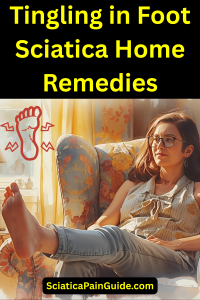Tingling in Foot Sciatica Home Remedies: Effective Relief Strategies
Living with Tingling, Numbness, and Sciatica Pain
If you’ve ever felt a tingling or pins-and-needles sensation in your foot, you know how frustrating and scary it can be. For many people in the U.S., this symptom is linked to sciatica, a condition caused by compression or irritation of the sciatic nerve. Alongside tingling, you may also struggle with sharp lower back pain, numb toes, leg weakness, or difficulty sitting and walking. The good news? There are tingling in foot sciatica home remedies that can help you manage symptoms naturally, reduce flare-ups, and regain mobility without relying solely on medications.
In this article, we’ll explore the causes of tingling in the foot, how sciatica leads to this symptom, and the most effective home remedies—plus practical lifestyle tips to keep the pain from returning.
What Causes Tingling in the Foot with Sciatica?
Tingling, numbness, or a “pins-and-needles” feeling in the foot often happens when the sciatic nerve is irritated or compressed. This nerve runs from the lower spine through the buttocks, down the leg, and into the foot.
Common Triggers of Sciatic Nerve Compression:
-
Herniated disc sciatica – A slipped or bulging disc pressing on the nerve.
-
Piriformis syndrome sciatica – The piriformis muscle in the buttock irritates the sciatic nerve.
-
Spinal stenosis – Narrowing of the spinal canal reduces space for nerves.
-
Spondylolisthesis – A slipped vertebra can pinch the nerve.
-
Prolonged sitting – Long hours at a desk or driving can worsen nerve compression.
Recognizing Sciatica Symptoms Beyond Tingling
Tingling in the foot is usually accompanied by other acute sciatica symptoms or chronic sciatica pain, such as:
-
Burning or sharp pain radiating down the leg
-
Numbness in toes or ankle
-
Muscle weakness in the leg or foot
-
Lower back pain and sciatica flare-ups
-
Pain that worsens when sitting with sciatica
-
Difficulty walking with sciatica pain
If these symptoms become severe or persist, consult a healthcare provider to rule out serious conditions.
Tingling in Foot Sciatica Home Remedies
Let’s dive into practical, natural remedies that you can try at home for tingling and nerve pain.
1. Heat or Ice for Sciatica Relief
-
Ice packs reduce inflammation during sudden flare-ups.
-
Heating pads relax tight muscles and improve circulation.
👉 Alternate between heat and ice for 15–20 minutes at a time.
2. Gentle Sciatica Stretches at Home
Daily stretching helps release pressure on the sciatic nerve. Try:
-
Knee-to-chest stretch
-
Seated hamstring stretch
3. Low-Impact Sciatica Exercises for Pain Relief
Movement prevents stiffness and promotes healing. Good options include:
-
Walking short distances
-
Water aerobics
-
Gentle yoga for sciatica
4. Posture and Sitting Adjustments
Avoid slouching or sitting too long. Use:
-
A chair with lumbar support
-
A cushion for sciatica pain relief
-
Frequent breaks to stand and stretch
5. Over-the-Counter Supportive Options
-
NSAIDs (ibuprofen, naproxen) for pain relief
-
Topical creams with menthol or capsaicin
-
Cushions and mattresses designed for sciatica
6. Natural Remedies for Sciatica Nerve Pain
-
Turmeric supplements (anti-inflammatory)
-
Magnesium-rich foods for muscle relaxation
-
Epsom salt baths to soothe nerve irritation
7. Best Sleeping Position for Sciatica Relief
-
Sleep on your side with a pillow between your knees
-
Or on your back with a pillow under your knees
Both reduce pressure on the lower spine.
Lifestyle Tips to Prevent Tingling in the Foot
Preventing sciatica flare-ups is often easier than treating them once they start. By making small but consistent adjustments to your daily routine, you can reduce nerve irritation, improve mobility, and keep tingling sensations under control.
1. Stay Active with Low-Impact Movement
Regular activity helps keep your muscles strong and flexible, which supports the spine and reduces nerve compression.
-
Aim for 20–30 minutes of walking at least 5 days a week.
-
Try low-impact cardio like swimming, cycling, or water aerobics.
-
Incorporate core-strengthening exercises to stabilize the lower back.
2. Maintain a Healthy Weight
Extra weight—especially around the abdomen—adds pressure to the lower spine and can worsen sciatic nerve pain.
-
Focus on a balanced diet rich in lean proteins, whole grains, fruits, and vegetables.
-
The U.S. CDC recommends aiming for 150 minutes of moderate exercise per week to support a healthy weight.
3. Practice Good Posture
Slouching or leaning forward while sitting can strain the sciatic nerve.
-
Keep both feet flat on the ground when sitting.
-
Use a lumbar support pillow if your chair lacks back support.
-
Switch between sitting and standing with a standing desk if possible.
4. Take Breaks from Sitting
Prolonged sitting is one of the top triggers for tingling in the foot from sciatica.
-
Stand up and stretch every 30–45 minutes.
-
Use a sciatica cushion or wedge seat to relieve pressure.
-
If driving long distances, plan rest stops to move and stretch.
5. Lift Objects Safely
Improper lifting can quickly trigger sciatica symptoms.
-
Bend at your knees and keep the load close to your body.
-
Avoid twisting your spine while carrying weight.
-
If something feels too heavy, ask for help.
6. Sleep in a Supportive Position
The wrong sleeping posture can put stress on the sciatic nerve.
-
Side sleepers: Place a pillow between your knees.
-
Back sleepers: Place a pillow under your knees.
-
Avoid sleeping on your stomach, which arches the spine.
7. Manage Stress and Tension
Stress can increase muscle tightness in the back and hips, worsening sciatica pain.
-
Practice deep breathing, meditation, or yoga.
-
Consider mindfulness apps like Headspace or Calm, popular in the U.S.
-
Gentle stretching before bed helps reduce tension.
8. Wear Supportive Footwear
Poor shoes can increase pressure on your lower back and aggravate tingling.
-
Choose shoes with arch support and cushioning.
-
Avoid high heels or completely flat shoes.
-
Orthotic inserts may help if you stand for long hours.
9. Limit Sciatica Triggers
Be aware of what sets off your symptoms and adjust accordingly.
-
Avoid carrying heavy bags on one shoulder.
-
Keep your wallet out of your back pocket to prevent wallet sciatica.
-
Minimize repetitive bending and twisting movements.
👉 These lifestyle changes don’t just prevent tingling—they support overall spine health and lower your chances of recurring chronic sciatica.
When to Seek Medical Help
While home remedies are helpful, seek medical care if you experience:
-
Suddenly, severe leg weakness
-
Loss of bladder or bowel control
-
Tingling or numbness that worsens despite home care
Doctors may recommend physical therapy, prescription medications, or minimally invasive treatments if conservative methods don’t work.
Real-Life Coping Strategies from Patients
Many people with sciatica in the U.S. manage symptoms with a mix of home care and medical support:
-
Using a standing desk to reduce sitting time
-
Taking short daily walks to relieve stiffness
-
Doing morning stretches to prevent flare-ups
-
Trying yoga or Pilates for flexibility
-
Combining heat therapy at night with gentle exercise during the day
FAQs on Tingling in Foot Sciatica Home Remedies
1. Can home remedies stop tingling in the foot from sciatica?
Yes, consistent use of stretching, posture correction, heat/ice therapy, and lifestyle changes can reduce tingling. However, severe or persistent symptoms may require professional treatment.
2. How long does tingling in the foot from sciatica last?
For mild cases, tingling may fade in days or weeks with home remedies. Chronic sciatica may take months and often requires physical therapy for long-term relief.
3. What are the best exercises for tingling in the foot from sciatica?
Gentle walking, yoga stretches, and targeted moves like the piriformis stretch, hamstring stretch, and core strengthening exercises help reduce nerve irritation.
4. Does sitting make sciatica tingling worse?
Yes, prolonged sitting often increases sciatic nerve pressure, leading to tingling or numbness in the foot. Using cushions, adjusting posture, and taking standing breaks can help.
5. Are natural remedies effective for sciatica tingling?
Yes, turmeric, magnesium, Epsom salt baths, and anti-inflammatory foods may reduce irritation. While not a cure, they can complement medical and exercise-based care.
6. Can sleeping positions affect sciatica tingling?
Absolutely. Sleeping on your side with a pillow between your knees or on your back with a pillow under your knees relieves lower back stress and reduces tingling.
7. When should I see a doctor for sciatica tingling?
If tingling worsens, spreads, or is accompanied by leg weakness, numbness, or bladder/bowel issues, seek immediate medical attention. These may signal severe nerve compression.
Conclusion: Take Control of Sciatica Tingling
Tingling in foot sciatica home remedies—from heat/ice therapy to targeted stretches, natural remedies, and posture adjustments—can make a big difference in daily comfort. While not a replacement for medical care, these strategies empower you to manage symptoms and prevent flare-ups.
Start small: pick one or two remedies and add them to your routine. Over time, consistency brings relief and helps you regain control over your mobility and quality of life.
Disclaimer
This article is for informational purposes only and does not replace professional medical advice. Always consult with a qualified healthcare provider before starting new treatments, exercises, or supplements for sciatica.

- How to Sit with Wallet Sciatica
- Sciatica Exercises to Avoid
- What Is the Best Pain Relief for Severe Sciatica





